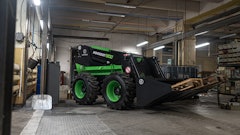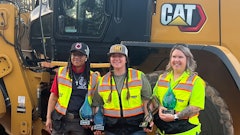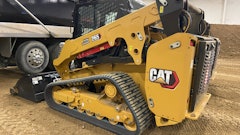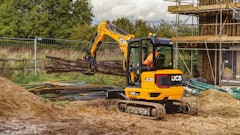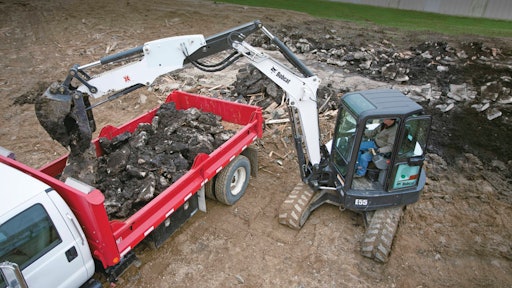
Hybrid rubber tracks, six-way blades, swing booms, proportional auxiliary hydraulics with increased flow, climate-controlled cabs and touch-screen monitors are just a few features expanding the role of the compact excavator.
Tim Connor, product specialist for the excavator line at Bobcat Company, confirms many advanced features now come standard on 10,000- to 20,000-lb. excavators. Bobcat offers password protection, auto Idle, fingertip proportional control of auxiliaries, fingertip control of boom swing, selectable flow rate, blade float and auto shift travel on all machines from 2 ton all the way up to 8 ton.
Cabs have also been growing, with better access. “Generally when you get to 6 tons in the industry the cab size jumps up slightly – width and depth,” notes Connor.
Kiser Skid Steer Services, Rigby, ID, is an excavation and hardscape company with vast compact excavator experience. The company currently runs a Case 160 and a Takeuchi TB153, but has rented machines for special tasks, including a Wacker compact excavator with the Vertical Digging System (VDS).
Shane Kiser explains that ingress/egress in and out of the cab is critical. “A compact is much different than a big machine. With a big machine you get in and you get comfortable. You may be there all day. With a compact you are always in and out.”
Many features are migrating down from the full-size excavators. “Many features on our compact excavator that weighs 5 metric tons come from the engineering group that worked on machines that weighed 800 metric tons. We leverage engineering across a very wide excavator range,” says Mark Wall, product marketing manager for John Deere and Hitachi excavators.
But actual features available depend on the model and size class. For instance, the John Deere 35G (8,135 lbs. with standard arm, counterweight and cab) shifts automatically from high to low speed just like a bigger excavator, and it is available with automatic climate control and auto idle. “As you get smaller some of these features tend to disappear,” Wall explains.
Auto two speed is available on many makes and models, including those from Wacker Neuson. “If you have it in two speed and you push with the blade, it will shift to first gear and give you all of the available pushing power,” says Adam Purcell, Wacker Neuson.
Advanced instrumentation is also trickling down from larger machines. That includes color screens, multi-layer screens and diagnostic capability. Bobcat offers selectable flow rates that can be adjusted through its monitor. But options on the display depend on machine size. Elaborate full-color, multi-language, full-diagnostic displays are available on the E63 and E85, while the E55 (5 1/2-ton)machine display is slightly scaled back.
The Kubota digital control panel includes attachment presets that complement the proportional controls. “Even if the battery is disconnected, the system remembers flow settings for easy selection the next time the attachment is used,” says Keith Rohrbacker, Kubota product manager.
John Deere is also expanding use of digital monitors. “With our monitor you can actually set how much time you want the machine to idle before it shuts down,” says Wall. “It saves a lot of fuel.” The monitor also allows operators to disable regen cycles on Tier 4 equipment when needed and it provides diagnostic codes for troubleshooting.
Game changing features
Compact excavators historically offered features not available on the larger compact machines. “Once you tipped 12,000-lbs. operating weight, two features were a rarity,” recalls Connor. These include the swing boom and a blade. “In the last two to three years those are becoming the norm.”
The swing boom allows you to dig parallel to a building or concrete barriers. “I see almost no value in a conventional boom compact excavator. The whole advantage to that compact is so you can work in tight areas where that conventional boom really doesn’t shine,” says Kiser.
Traditionally, blades have been standard on 5-ton and smaller excavators. They help level the machine, support or stabilize the machine if you are digging or lifting over the blade, and push material. “As you get into bigger machines there is less emphasis on leveling and dozing to the extent that you would with the smaller machines,” says Connor. “It gets to the point where you can’t afford to be running an undercarriage of this magnitude in a grading and dozing application.”
Wacker equips its entire line of excavators, which extends up to 8 tons, with dozer blades. “We do offer an angle blade, but it is only on the 6 ½-ton excavator,” says Purcell.
Every compact John Deere excavator under 6 metric tons is also equipped with a blade. “Three of our compacts have an angle blade, which benefits customers who trench and want to backfill in a hurry,” notes Wall.
“The angle blade improves productivity, saving perhaps 60 percent of your backfilling time,” says Rohrbacker. Kubota offers an angle dozer blade option on all its excavators greater than 10,000 lbs. It also offers a 6-way dozer blade on the KX121-3 (9,815lbs.).
Rubber displaces steel
Rubber tracks have also migrated up the compact excavator range. “Ten years ago it was almost the norm that 12,000- to 14,000-lb. excavators were on steel track,” says Connor. “But we have seen a transition where it is predominantly rubber track.” Rubber tracks allow you to unload the machine on the street and move it without any ramifications.
Typically steel tracks are available on compact excavators as an option, but the vast majority of compact excavators do go out on rubber. “When we first got into a 6-ton machine 10 years ago, 80% of the customers were using steel track. Five years ago I bet we were selling 90% of them with rubber track,” says Connor.
Kubota offers rubber tracks as standard, with steel tracks available as an option from the 2- to 3-ton class and up. “Our customers in demolition and landscaping applications need the increased durability of steel tracks, and some customers operating on native rock that easily cuts rubber tracks,” says Rohrbacker. “Ultimately the selection seems to be centered more on application rather than machine size.”
John Deere uses rubber tracks as the primary undercarriage on machines less than 6 tons. But the larger 75G (18,221 lbs.) and 85G (18,821 lbs.) tend to work in more diversified environments. “Customers want the ability to put steel pads on them and go out in rougher environments,” says Wall.
To address this diversity, John Deere offers hybrid track on its 75G and 85G. “It is a steel chain with vulcanized rubber pad mounted to the chain,” says Wall. “The rubber pad is a great option if you are in an environment detrimental to the rubber belt. Demolition is a great example because you don’t lose the ability to operate on pavement. If you are working in broken concrete and you damage a rubber pad, you remove four bolts, throw the pad away and put the new pad in without having to replace the whole belt.”
Wacker Neuson also offers hybrid tracks. “The hybrid tracks are becoming a trend in the industry,” says Purcell. “They give you the best of both worlds. There is a premium price, but it saves on the replacement costs. Instead of replacing an entire set of tracks, you replace one pad at a time. You basically have the same driveability as the rubber track, but in terms of serviceability it is a much better solution.”
Now there is even an option to eliminate tracks completely. Wacker-Neuson offers 6- and 9 ½-ton wheeled excavators. “They are not very common here,” notes Purcell. But they are well-proven in Europe. “You get all of the advantages of a compact excavator on wheels that travel 25 mph.” Both units offer blades and the 9 ½-ton machine also has rear stabilizers.
These machines promise the same performance as their tracked counterparts. “We see major opportunities with the municipalities and in the urban excavating environment where it is very difficult to deal with a truck and trailer,” says Purcell.
Selectable power modes make appearance on compact excavators
Several manufacturers now offer power modes. “We have both an Economy Mode and a Power Mode, which is really going to provide quite a bit of fuel savings,” notes Deere’s Bower. We also have integrated an auto Idle and an auto shut down function that has really taken off in the marketplace.”
Kubota has also introduced the Eco Plus system on its four new excavators, KX040-4 and larger. “EcoPlus allows our customers to select ‘eco mode’ when fuel conservation is a priority, offering fuel savings of up to 20 percent,” says Rohrbacker. Auto idle is standard on the company’s machines from 3 to 4 tons and larger. “When the control levers are in the neutral position for more than four seconds, the engine rpm automatically idles. Move any control lever and the engine rpm immediately returns to the pre-set level.”
Hydraulics improve
Compact excavators are really evolving into tool carriers. “Depending upon the attachments you want to run, you need to look at the auxiliary flow rates,” says Purcell.
“For me, auxiliary flow is important,” notes Kiser. “That has been one of the biggest improvements. Everybody has upped the flow on the auxiliary line so you can effectively run larger compaction attachments. Many previous models offered 15 gpm. “It is just not enough.” The latest Takeuchi model Kiser purchased in 2012 offer 23 gpm. “It runs all of the attachments very well. That’s good because I can put more attachments on it and get a better return on my investment.”
Wacker Neuson pays particular attention to demolition attachment performance. “All of our machines in this weight class have two return lines standard,” says Purcell. “One is direct to tank. If you are running one-way attachments, like a hammer, you will have as good of performance as possible because of that direct to tank return line.” The major advantage is you have no backpressure to drag performance down.
Most manufacturers now offer proportional controls of auxiliary hydraulics. “My newest Takeuchi is proportional and it is much nicer,” says Kiser. “You can feather the thumb switch where before it was pretty much on or off. If you were handling pipe or culvert you had to be careful that you didn’t crush them.”
There has also been an effort to make more room on the floor where the traditional auxiliary controls are located. In the case of John Deere, the pedals that run the auxiliary hydraulic circuits fold out of the way when not needed.
Bobcat takes a different approach. “The auxiliary control method has historically been a foot pedal,” notes Connor. “Those are now fingertip and proportional. The operator who runs a clamp attachment every day clamors to work with fingertip control, especially when coming up from a smaller machine.” Fingertip controls are also used to control boom swing.
Compare boom and stick offerings
There are several boom and stick offerings, including an extendible arm. Bobcat offers an optional extendible arm its 5 ½-ton excavator. It can provide needed reach without requiring you to jump to the next size machine. “To get another 2 or 3 ft. of reach, if you simply went by the next size machine, you would jump up 5,000 lbs. in weight,” says Connor. “With an extendible arm you are basically adding 400 lbs. at the most.” This can be important depending upon the trailer and the tow vehicle you use to move the machine between jobsites.
Bobcat has offered extendible arms on smaller machines for years. “In the last year we released extendible arms on big machines,” says Connor. “We sell it on our 4-ton, 4 ½-ton and our 5-ton excavators. It is a decent percentage of that volume.”
Bobcat has designed its extendible arms to be compatible with clamps. “One roadblock through the years is extendible arms were typically non-compatible with a clamp,” says Connor.
Kubota offers an extendible arm option for the KX91-3 (7,635 lbs.) and an extendible boom option for the KX080-3 (19,204 lbs.). “With the Super Double boom’s wide leveling range and a wide tilt bucket, operators can easily level and finish, even on the uneven surfaces,” says Rohrbacker. “The extended reach, combined with the added dumping height, makes it easy to place the spoil in the center of the truck and knock the top of the pile.”
John Deere takes a different approach, offering two different arms – a standard and a long. “There are advantages to offering either a short arm or long arm,” says Wall. “We take away that wear point of having that extendible arm and give you the functionality of having a longer arm if you need more reach and dig depth.” Counterweight is added with the long arm so the excavator maintains the same lift capacity it has with the short arm. “By having a long arm with a heavier counterweigh it gives the same feel as a machine that would be equipped with a standard counterweight and a short arm.”
Wacker takes a similar approach, offering both a standard and long dipper stick. “Typically the extra digging depth is between 8 to 12 in. for the long dipper. “The cost associated with that is you lose arm breakout force. If you dig in tough material, unless you absolutely need the extra dig depth, go with the standard dipper stick.” Different counterweight packages are offered depending upon the boom and stick configuration. By using this approach, Wacker is able to optimize the performance of the excavator. Extra weight on the front of the machine is minimized and there are no concerns about proper counterweight.






